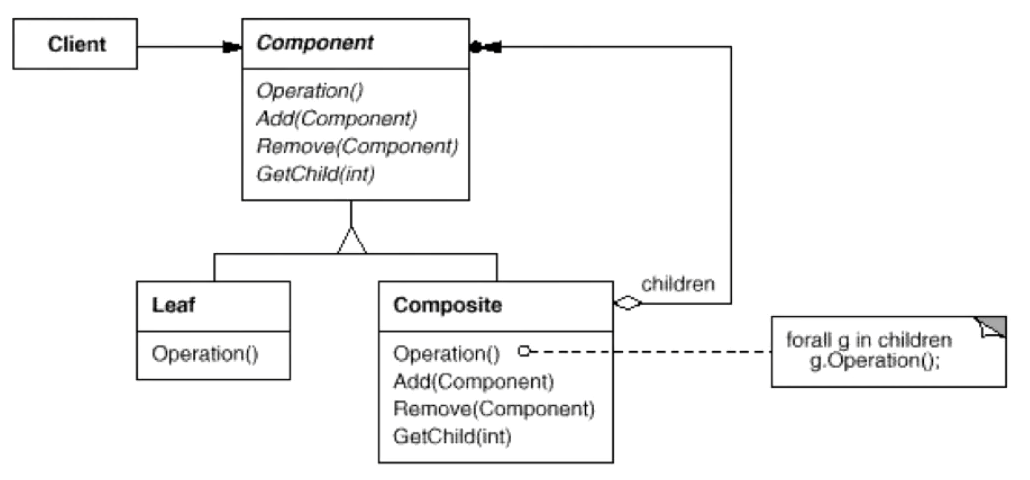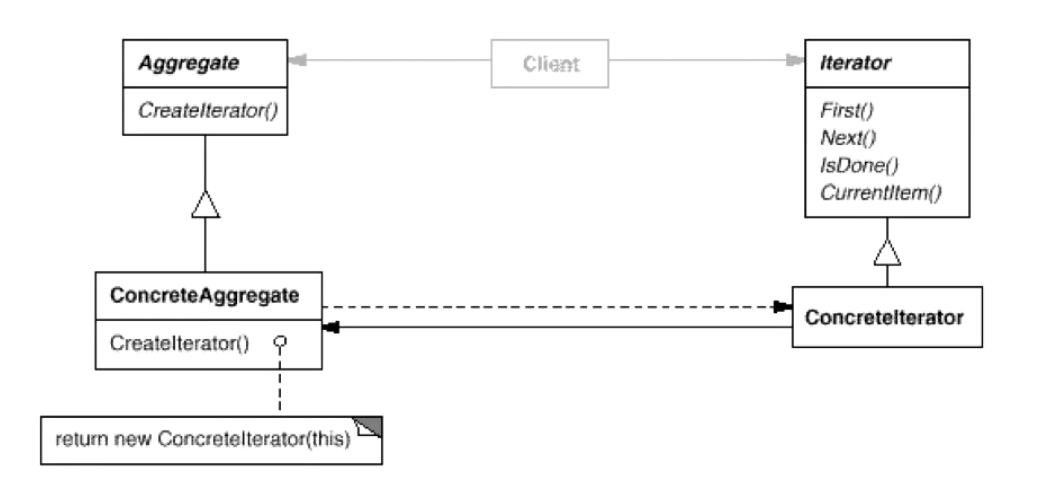Composite
组合模式
将对象组成树形结构以表示“部分-整体”的层次结构。Composite使得用户对单个对象和组和对象的使用具有一致性(稳定)。
解决什么问题
软件在某些情况下,客户代码过多地依赖于对象容器负载的内部实现结构,对象容器内部实现结构(而非抽象接口)的变化将引起客户代码(invoke函数)的频繁变化,带来了代码的维护性、扩展性等弊端。
如何将“客户代码与复杂对象容器结构”解耦?让对象容器自己来实现自身的复杂结构,从而使得客户代码就像处理简单对象一样来处理复杂的对象容器。
结构

要点总结
- Composite模式采用树形结构来实现普遍存在的对象容器,从而将“一对多”的关系转化为“一对一”的关系,使得客户代码可以一致地(复用)处理对象和对象容器,无需关心处理的是单个的对象,还是组合的对象容器。
- 将“客户代码与复杂的对象容器结构”解耦是Composite的核心思想,解耦之后,客户代码将与纯粹的抽象接口——而非对象容器的内部实现结构——发生依赖,从而更能“应对变化”。
- Composite模式在具体实现中,可以让父对象中的子对象反向追溯;如果父对象有频繁的遍历需求,可以使用缓存技巧来改善效率。
示例
class Component {
public:
virtual void process() = 0;
virtual ~Component() {}
};
class Composite : public Component {
private:
string name;
list<Component*> elements;
public:
Composite(const string& s) : name(s) {}
void add(Component* element) {
elements.push_back(element);
}
void remove(Component* element) {
elements.remove(element);
}
void process() {
// process current node
// process leaf nodes
for (auto &e : elements) {
e->process();
}
}
};
class Leaf : public Component {
private:
string name;
public:
Leaf(string s) : name(s) {}
void process() {
// process current node
}
};
// 稳定
void Invoke(Component& element) {
// ...
element.process();
}
int main() {
Composite root("root");
Composite treeNode1("treeNode1");
Composite treeNode2("treeNode2");
Composite treeNode3("treeNode3");
Composite treeNode4("treeNode4");
Leaf left1("left1");
Leaf left2("left2");
root.add(&treeNode1);
treeNode1.add(&treeNode2);
treeNode2.add(&left1);
root.add(&treeNode3);
treeNode3.add(&treeNode4);
treeNode4.add(&left2);
process(root);
}
Iterator
迭代器
提供一种方法顺序访问一个聚合对象中的各个元素,而又不暴露(稳定)该对象的内部表示。
解决什么问题
在软件构建过程中,集合对象内部结构常常变化各异。但对于这些集合对象,我们希望不暴露其内部结构的同时,可以让外部客户嗲吗透明地访问其中包含的元素;同时这种“透明遍历”也为“同一种算法在多种集合对象上进行操作”提供了可能。
使用面向对象的技术将这种遍历机制抽象为“迭代器对象”为“应对变化中的集合对象”提供了一种优雅的方式。
结构

要点总结
- 迭代抽象:访问一个聚合对象的内容而无需暴露它的内部表示。
- 迭代多态:为遍历不同的集合结构提供一个统一的接口,从而支持同样的算法在不同集合结构上进行操作。
- 迭代器的健壮性考虑:遍历的同时更改迭代器所在的集合结构,会导致问题。
示例
template<typename T>
class Iterator {
public:
virtual void first() = 0;
virtual void next() = 0;
virtual bool isDone() const = 0;
virtual T& current() = 0;
};
template<typename T>
class MyCollection {
public:
Iterator<T> GetIterator() {
// ...
}
};
template<typename T>
class CollectionIterator : public Iterator<T> {
private:
MyCollection<T> mc;
public:
CollectionIterator(const MyCollection<T>& c) : mc(c) { }
void first() override {
}
void next() override {
}
bool isDone() const override {
}
T& current() override {
}
}
void MyAlgorithm() {
MyCollection<int> mc;
Iterator<int> iter = mc.GetIterator();
for (iter.first(); !iter.isDone(); iter.next()) {
// ...
}
}
Chain of Resposibility
职责链
使多个对象都有机会处理请求,从而避免请求的发送者和接收者之间的耦合关系。将这些对象连成一条链,并沿着这条链传递请求,直到有一个对象处理它为止。
解决什么问题
在软件构建过程中,一个请求可能被多个对象处理,但是每个请求在运行时只能有一个接受者,如果显示指定,将必不可少地带来请求发送者与接受着的紧耦合。
如何使请求的发送者不需要指定具体的接受者?让请求的接受者自己在运行时决定来处理请求,从而使两者解耦。
结构

要点总结
- Chain of Responsibility 模式的应用场合在于“一个请求可能有多个接受者,但最后真正的接受者只有一个”,这时候请求发送者与接受者的耦合有可能出现“变化脆弱”的症状,职责链的目的就是将二者解耦,从而更好地应对变化。
- 应用了Chain of Responsibility模式后,对象的职责分派将更具灵活性。我们可以在运行时动态添加/修改请求的处理职责。
- 如果请求传递到职责链的末尾仍得不到处理,应该有一个合理的缺省机制。这也是每一个接受对象的责任,而不是发出请求的对象的责任。
示例
class Request {
private:
string description;
RequestType reqType;
public:
Request(const string& desc, RequestType type) : description(desc), reqType(type) {}
RequestType getReqType() const { return reqType; }
const string& getDescription() const { return description; }
};
class ChainHandler {
private:
ChainHandler* nextChain;
void sendRequestToNextHandler(const Request& req) {
if (nextChain != nullptr) {
nextChain->handle(req);
}
}
protected:
virtual bool canHandleRequest(const Request& req) = 0;
virtual void processRequest(const Request& req) = 0;
public:
virtual ~ChainHandler() {}
ChainHandler() {
nextChain = nullptr;
}
void setNextChain(ChainHandler* next) {
nextChain = next;
}
void handle(const Request& req) {
if (canHandleRequest(req)) {
processRequest(req);
}
else {
sendRequestToNextHandler(req);
}
}
};
class Handler1 : public ChainHandler {
protected:
bool canHandleRequest(const Request& req) override {
return req.getReqType() == RequestType::REQ_HANDLER1;
}
void processRequest(const Request& req) override {
// ...
}
};
class Handler2 : public ChainHandler {
protected:
bool canHandleRequest(const Request& req) override {
return req.getReqType() == RequestType::REQ_HANDLER2;
}
void processRequest(const Request& req) override {
// ...
}
};
class Handler3 : public ChainHandler {
protected:
bool canHandleRequest(const Request& req) override {
return req.getReqType() == RequestType::REQ_HANDLER3;
}
void processRequest(const Request& req) override {
// ...
}
};
int main() {
Handler1 h1;
Handler2 h2;
Handler3 h3;
h1.setNextChain(&h2);
h2.setNextChain(&h3);
Request request("process task ...", RequestType::REQ_HANDLER3);
h1.handle(request);
return 0;
}